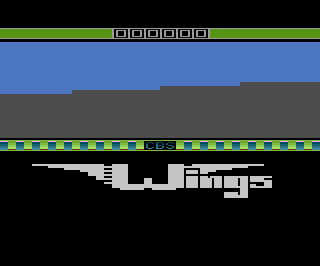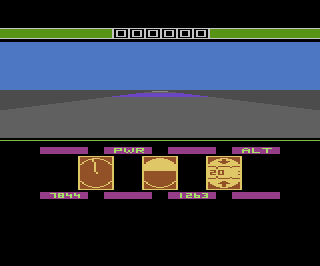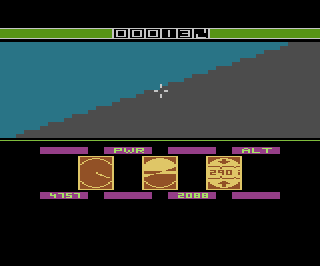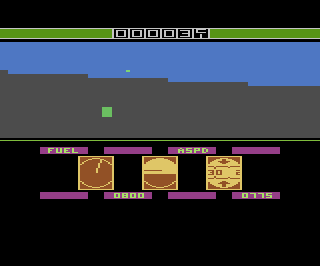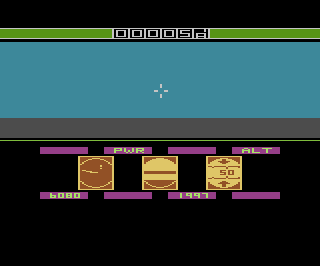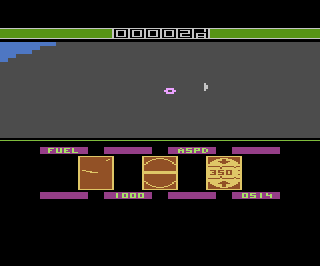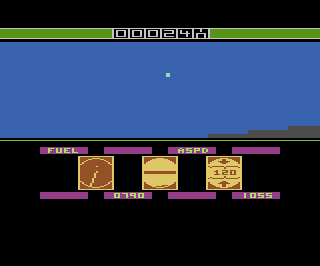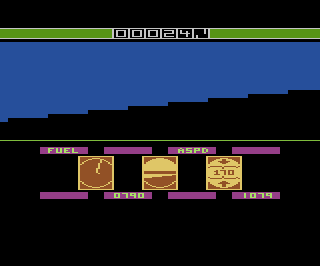|
|
Wings
|
Name:
|
Wings |
|
| Company: | CBS Electronics | |
|
Model #:
|
Unknown | |
|
Programmer:
|
Stuart Ross | |
| Year: | 1983 | |
|
Released?
|
No
|
|
|
Notes:
|
A RAM Plus Cartridge |
As you might have guessed with a name like Wings, this game is all about planes. Wings an air combat simulation game similar to the Atari Lynx title War Birds. Wings was originally intended to be a 4K game, but it was decided that trying to cram a complete flight simulator into a tiny 4K cartridge was too difficult. Therefore Wings was shelved until the development of the RAM Plus chip (a 10.5K RAM chip) made it possible. Wings was thought to exist as a prototype for many years, but wasn't discovered until late 2004. It was originally assumed that Wings would use the Booster Grip controller for its complex controls, but when the prototype was finally found it was discovered that it supported not only the Booster Grip, but also a strange two joystick scheme instead (similar to the late Atari release Radar Lock).
The Left Joystick
The Left Joystick is used to control your plane. Pressing the fire button and pushing up will throttle up the engines, while pressing the fire button and pushing down will throttle down the engines.
The Right Joystick
The Right Joystick is used to access your weapons. Your weapon systems are only enabled after clearing the runway or reaching an altitude of 60 Feet. Pushing down will switch between machine guns and missiles, while pressing up will fire your weapons. Guns are weak, but have unlimited ammunition. Missiles on the other hand are very powerful, but you only get two. Use them wisely.
Before diving into the gameplay, this would be a good time to discuss the the instrument panel as it is vital to your survival. Your instrument panel contains four different gauges: Fuel, Power, Airspeed, and Altitude. Each of these gauges uses a digital readout to display to keep your informed on how your plane is performing.
Fuel Gauge (FUEL) - Measures how much fuel you have remaining (duh!). If
your fuel drops below 1500 it will begin to beep and flash warning
you that you are about run out of fuel and crash.
Power Gauge (PWR) - Measures the current power of your engines. More
power means more speed, but it also eats up more fuel.
Airspeed Gauge (ASPD) - Measures your current airspeed. You
must maintain an average airspeed of at least 1535 MPH or this gauge
will begin to flash and beep. If you exceed 8000 MPH your plane
will fall apart.
Altitude Gauge (ALT) - Measures your current altitude. You
must maintain an altitude of at least 512 Feet or this gauge will
begin to flash and beep.
Fuel Gauge (FUEL) - Measures how much fuel you have remaining (duh!). If your fuel drops below 1500 it will begin to beep and flash warning you that you are about run out of fuel and crash.
Power Gauge (PWR) - Measures the current power of your engines. More power means more speed, but it also eats up more fuel.
Airspeed Gauge (ASPD) - Measures your current airspeed. You must maintain an average airspeed of at least 1535 MPH or this gauge will begin to flash and beep. If you exceed 8000 MPH your plane will fall apart.
Altitude Gauge (ALT) - Measures your current altitude. You must maintain an altitude of at least 512 Feet or this gauge will begin to flash and beep.
Also appearing on your instrument panel are three displays:
Radar (left) - Shows you where the enemy planes are.
Artificial Horizon (middle) - This gauge shows you how level your plane is.
Compass (right) - Shows the direction your plane is heading in.
After a rousing rendition of Flight of Valkyries (which can be toggled on/off with the left difficulty switch), you start the game on the runway (naturally). To take off you must throttle up your engines and achieve an airspeed of at least 512 MPH. Once you've reached 512 MPH you can begin to lift the nose up (push down) and go airborne. The runway will change colors (from Blue -> Gray -> Red -> Green/White) to help you tell how far away from the end you are. Once you're in the air, things get a little more tricky. You will need to maintain an average airspeed of at least 1535 MPH to remain airborne or your gauge will begin to flash and beep. If your speed drops below 780 MPH you will begin to go into a nose-dive and eventually crash. You will also need to keep an altitude of at least 512 Feet or the altitude gauge will begin to flash and beep warning you that you're too low to the ground.
Keep in mind that the direction of your nose will change how the plane reacts. If your nose is pointed upwards you will gain altitude, but will also lose speed. Likewise if your nose is pointed downwards you will gain speed, but lose altitude. Figuring out the proper positioning of your plane's nose is key to staying airborne. If your plane is level you can keep the a constant speed and altitude by throttling the engines to around 500. This will help keep everything under control while you're busy shooting down planes.
Once you're flying a bit you will undoubtedly notice that you are not alone. Enemy planes and ground guns will begin to take pot shots at you shortly after take off. At first you may only see their bullets flying at you (represented by a spinning square), but if you get close enough you'll actually see the enemy themselves. Thankfully your plane is armed with the latest in air to air combat weaponry. To shoot your guns at the enemy planes, get one in your crosshairs and press up on the second controller. You can also shoot missiles at the planes (press down on the second controller to switch to missiles), but you only get two so use them wisely. Missiles are much more powerful than your machine guns, but should only be used in emergencies. You can tell when you have your missiles armed by the targeting box that replaces your normal crosshairs.
Wings isn't a bad game, but grows repetitive after while for those of us who don't absolutely love air combat games. There just aren't enough enemies to keep the game interesting, as you can fly around for long periods of time without ever getting a blip on your radar. Another issue is there there are no clouds in the sky nor objects on the ground to give you a sense of speed. Apparently marketing wanted to add some clouds, but they never got implemented. Wings is more complex than other 2600 air combat games like Air Raiders, but not so complex that it becomes a chore to keep your plane flying. It appears that Stuart was able to strike the perfect balance between accurate flight sim and action oriented dog fighting. Sadly CBS decided to pull the plug on Wings mere weeks before it was ready to be released when they closed down cartridge development on October 23rd 1983. The decision was made so late that promotional material (hats and scarves) and even a commercial had been made.
There are two different Wings prototypes known to exist. The earlier version dated June 3rd is in NTSC format, but is missing the enemy planes making it pretty boring to play. The later version dated October 10th has the enemy implemented, but is in PAL format (CBS may have been planing on making Wings a PAL only release towards the end). Oddly enough Stuart doesn't remember working on a PAL version of Wings. It is hoped that a later and more complete version of Wings (from 10/23) may possibly exist on 7-inch disk, expect more information on this soon.
Prototype Wings Box (Thanks to AGH)
| Version | Cart Text | Description |
| 6/3/83 | NTSC Vesion. Missing enemy planes. | |
| 10/10/83 | Wings 10/10 21:40 | PAL Version. Almost complete. |

